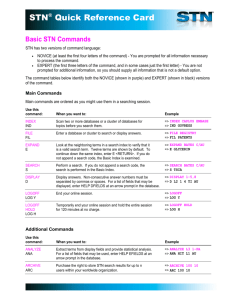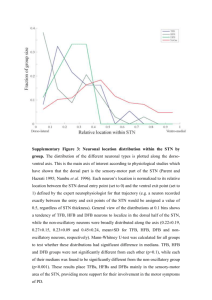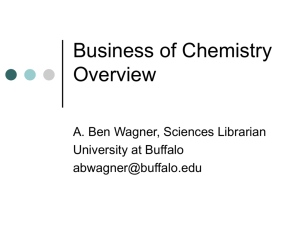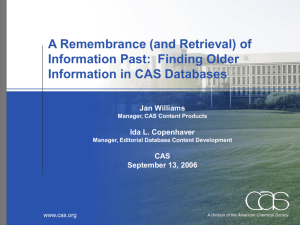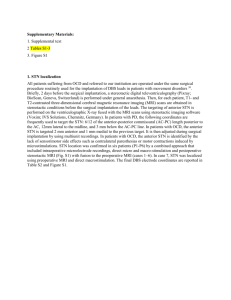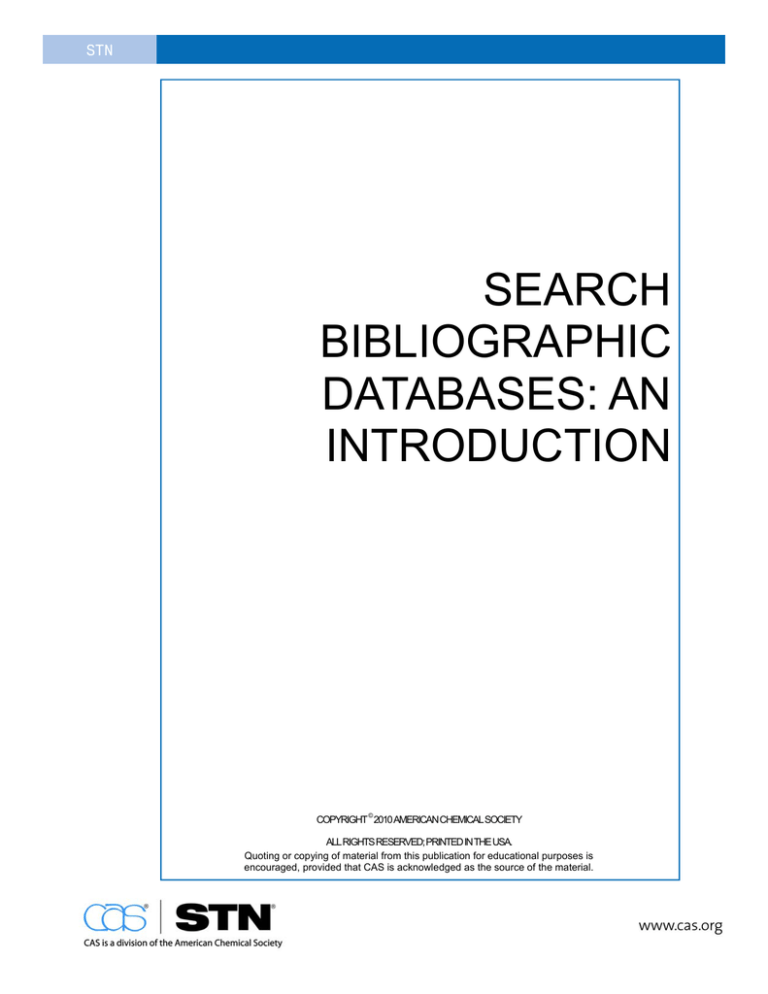
STN
SEARCH
BIBLIOGRAPHIC
DATABASES: AN
INTRODUCTION
©
COPYRIGHT 2010 AMERICAN CHEMICAL SOCIETY
ALL RIGHTS RESERVED; PRINTED IN THE USA.
Quoting or copying of material from this publication for educational purposes is
encouraged, provided that CAS is acknowledged as the source of the material.
STN
WHAT YOU WILL LEARN
In this workbook, you will learn how to:
•
Find information about the content of various databases
•
Determine what steps are required for planning and conducting a search
•
Use the main commands for conducting an online session
RECOMMENDED BASIC TEXT LEARNING PATH
The basic text search workbooks are intended for new users to learn the
fundamentals of searching STN® or an experienced user, for a review of specific
techniques.
If you are new to database searching, it is recommended that you use these
workbooks in the order shown, since each workbook builds on concepts and skills
covered in preceding workbooks.
1. Connect to STN
2. Work with Transcripts
3. Search Bibliographic Databases: An Introduction
4. Search for Multiple Terms in Bibliographic Databases
5. Evaluate and Display Search Results
6. Broaden a Search
7. Refine a Search
8. Search Author Names
9. Search Organization Names
10. Save Data
11. Access Online Help
Other STN learning paths are also available in the Learning Solutions resource
center at learningsolutions.cas.org.
Workbook Convention
STN Express® is used to illustrate concepts throughout these training workbooks,
although the command line techniques also apply to STN® on the WebSM.
2
STN
FIND STN DATABASE INFORMATION
STN provides electronic access to more than 150 scientific and technical databases
(also called files).
STN databases are created by extracting pieces of information from original,
published documents such as patents, journals, and dissertations. Most STN
databases contain bibliographic information, such as the document title, authors,
publisher, and abstract. Some databases include information about chemical
structures, reactions, and/or properties.
While most databases are in English, some databases are in other languages, such
as PATDPAFULL which is in German.
STN Database Summary Sheets (DBSS)
The Database Summary Sheets are PDF files and are used as the primary reference
for learning about the content, fields, and features in a database.
Each DBSS includes information about:
•
The content of the database
•
Search and display fields for individual records
•
Sample records
Example: Front Page of a DBSS
3
STN
STN Learning Databases
Several STN databases offer learning versions in which you can practice searching
prior to using the regular databases. The learning databases are indicated with the
letter L preceding the name, such as LCASM for the CASM database that contains
Chemical Abstracts information. Each learning database contains a static subset of
records taken from the primary database.
Most STN training workbooks include practice search exercises that you can do in
the LCA, CA, or CAplusSM databases. The difference between the CA and CAplus
database is that the CA database is updated weekly and the CAplus database is
updated daily.
4
STN
INTRODUCTION TO BIBLIOGRAPHIC
RECORDS
STN databases contain records. In a bibliographic database, each record includes
data for a single document such as a journal article.
BIBLIOGRAPHIC INFORMATION FOR A JOURNAL
CAplus records have three sections:
•
Bibliographic information
•
Abstract
•
Indexing
The following example displays the content of a bibliographic record for a journal
article in the CAplus database. It displays the name of each field, followed by the
corresponding data extracted from the original document.
ACCESSION NUMBER:
DOCUMENT NUMBER:
TITLE:
AUTHOR(S):
CORPORATE SOURCE:
SOURCE:
PUBLISHER:
DOCUMENT TYPE:
LANGUAGE:
2008:928341 CAPLUS Full-text
149:302606
Moromycins A and B, Isolation and Structure
Elucidation of C-Glycosylangucycline-Type Antibiotics
from Streptomyces sp. KY002
Abdelfattah, Mohamed S.; Kharel, Madan Kumar;
Hitron, John Andrew; Baig, Irfan; Rohr, Jurgen
Department of Pharmaceutical Sciences, College of
Pharmacy, University of Kentucky, Lexington, KY,
40536-0082, USA
Journal of Natural Products (2008), 71(9), 15691573
CODEN: JNPRDF; ISSN: 0163-3864
American Chemical Society-American Society of
Pharmacognosy
Journal
English
Based on your settings, STN can display abbreviations, or field codes, for each field.
The same record is shown here using the field codes.
AN
DN
ED
TI
AU
CS
SO
PB
DT
LA
2008:928341 CAPLUS Full-text
149:302606
Entered STN: 05 Aug 2008
Moromycins A and B, Isolation and Structure Elucidation of
C-Glycosylangucycline-Type Antibiotics from Streptomyces sp. KY002
Abdelfattah, Mohamed S.; Kharel, Madan Kumar; Hitron, John Andrew; Baig,
Irfan; Rohr, Jurgen
Department of Pharmaceutical Sciences, College of Pharmacy, University of
Kentucky, Lexington, KY, 40536-0082, USA
Journal of Natural Products (2008), 71(9), 1569-1573
CODEN: JNPRDF; ISSN: 0163-3864
American Chemical Society-American Society of Pharmacognosy
Journal
English
5
STN
Abstract
In the CAplus database, abstracts are entered in English, regardless of the original
language of publication, as shown in the example below.
AB
Two new anticancer antibiotics of the angucycline class, moromycins A and
B, along with the known microbial metabolites saquayamycin B and fridamycin D
were isolated from the Et acetate extract of a culture broth of the terrestrial
Streptomyces sp. KY002. The structures consist of a tetrangomycin core and
various C- and O-glycosidically linked deoxysugars. The chemical structures of
the new secondary metabolites were elucidated by 1D and 2D NMR and by mass
spectrometry. Moromycin B showed significant cytotoxicity against H-460 human
lung cancer and MCF-7 human breast cancer cells.
Indexing
Indexing in CAplus consists of CAS classification codes, supplementary terms, and
indexing terms. The indexing fields can have other names in other bibliographic
databases, such as Controlled Term (CT). Consult the relevant Database Summary
Sheet for details.
Classification Code, CC
The Classification Code is a broad area or section of chemistry and chemistryrelated sciences, as defined by CAS.
CC
10-1 (Microbial, Algal, and Fungal Biochemistry)
Section cross-reference(s): 26
Supplementary Terms, ST
Supplementary Terms are keywords that identify main concepts for the original
document’s subject matter and usually are related directly to terms used by authors
in the original publication. These terms can include newly coined scientific or
technical terminology and are not standardized.
ST
moromycin angucycline anticancer antibiotic natural product Streptomyces;
lung mammary neoplasm antitumor antibiotic moromycin glycosylangucycline
Index Terms, IT
The Index Term field includes standardized, in-depth indexing for the original
document’s subject matter. Identifying the database’s controlled vocabulary is an
effective way to assist with retrieving relevant records. The use of index terms is
discussed in the Evaluate and Display Search Results workbook.
IT
IT
Antitumor agents
(antibiotic; isolation and structure elucidation of
C-glycosylangucycline-type antibiotics moromycins A and B from
Streptomyces sp. KY002)
Antibiotics
(antitumor; isolation and structure elucidation
of
®
CAS Registry
Numbers
and related
are
C-glycosylangucycline-type
antibiotics
moromycins
A and Bindexing
from
Streptomyces sp. KY002)
explained in the substance searching workbooks.
•••
IT
6
1044869-32-0P, Moromycin A
RL: BSU (Biological study, unclassified); NPO (Natural product
occurrence); PRP (Properties); PUR (Purification or recovery); BIOL
(Biological study); OCCU (Occurrence); PREP (Preparation)
(isolation and structure elucidation of C-glycosylangucycline-type
antibiotics moromycins A and B from Streptomyces sp. KY002)
STN
SEARCH AND DISPLAY FIELDS
The content of a bibliographic record is organized into fields which can be searched
and/or displayed. For example, author names are extracted and placed into the
author field. Each database summary sheet includes a list, with examples, of all the
search and display fields in the database.
The field codes are usually identical; the search field is indicated using a forward
slash (/). The SEARCH command statement is entered using the following format:
SEARCH <the search term>/ < field code>. For example, to search the term
“moromycin” in the title field, you would enter the following command:
=> SEARCH MOROMYCIN/TI
The following table lists search and display fields and field codes commonly found in
bibliographic databases.
COMMON
SEARCH FIELD
CONTENT
SEARCH FIELD
CODE
DISPLAY FIELD
CODE
Title
Document title
/TI
TI
Author
Author names
/AU
AU
Corporate
Source
Company or organization name
for author affiliation
/CS
CS
Publication Year
Publication year of the original
publication
/PY
PY
Language
Language of the original
publication
/LA
LA
Document Type
Type of document, e.g., journal,
patent
/DT
DT
Basic Index, BI
Every STN database includes a special search field called the Basic Index (BI). The
Basic Index is composed of a predefined set of fields. If you do not specify a search
field, the Basic Index is searched by default.
The fields included in the Basic Index vary between databases. The Database
Summary Sheet lists the fields included in the Basic Index for a particular database.
It is always the first search field listed.
For example, the Basic Index for CAplus is composed of single words from the Title
(TI), Supplementary Terms (ST), Index Terms (IT), and Abstract (AB) fields.
7
STN
INTRODUCTION TO AN ONLINE SESSION
STN uses a command-line interface, which means that you must type commands
instead of either selecting them from a menu or clicking an icon. To conduct an
online STN session, you need a minimum of four commands:
•
FILE
•
SEARCH
•
DISPLAY
•
LOGOFF
Typing the entire command at the command prompt and pressing Enter on the
keyboard is referred to as novice mode. When you enter information in this manner,
STN prompts you for the additional instructions required to execute the command.
You can also enter commands in a shorter format, referred to as expert mode. When
using expert mode, STN assumes that you understand any default values associated
with the command and have entered any instructions that differ from the default
values. More information about the default values is discussed later in this workbook.
NOVICE MODE
EXPERT MODE
TO
FILE
FIL
Enter the database
SEARCH
S
Conduct your search
DISPLAY
D
View search results
LOGOFF
LOG Y
End the STN session
ONLINE SESSION EXAMPLE
Planning and conducting a bibliographic search involves several steps. The following
example shows how to search on a single search term in the CAplus database.
Search Question
What references are available in CAplus concerning the Streptomyces bacteria?
8
STN
Plan the Search
Plan a search prior to your STN session. The following suggestions can help you
prepare:
•
Identify the database in which to conduct the search
•
Select the search term
•
Choose a search field for your search term(s) and the DISPLAY format or field(s)
you want to use
While several STN databases contain data about this topic, CAplus is used because
it has excellent coverage in the area of biochemistry.
The search question consists of one concept that can be covered by one search
term: “Streptomyces.” The word “bacteria” is not used because it is too general.
“Streptomyces” is a better choice since it is the genus of bacteria given in the search
question.
The Basic Index is chosen because the term can be searched in multiple fields
simultaneously.
ACTION
OPTION CHOSEN
Identify database
CAplus
Identify main concepts (search terms)
Streptomyces
Choose search field
Basic Index
Open a Database using the FILE Command
To open a database in STN, type the word FILE at the command prompt. STN then
asks you for any instructions it needs to complete the command, in this case, the
name of the database. Type the name of the database and then press Enter.
When you enter the database, STN displays the time and date of entry, copyright
information, and any database-specific information.
FILE 'HOME' ENTERED AT 13:37:44 ON 19 MAR 2010
=> FILE CAPLUS
COST IN U.S. DOLLARS
FULL ESTIMATED COST
SINCE
FILE
You can
use bothTOTAL
uppercase and
ENTRY to enter
SESSION
lowercase
commands.
0.66
0.88
FILE 'CAPLUS' ENTERED AT 17:44:33 ON 27 MAY 2010
USE IS SUBJECT TO THE TERMS OF YOUR STN CUSTOMER AGREEMENT.
PLEASE SEE "HELP USAGETERMS" FOR DETAILS.
COPYRIGHT (C) 2010 AMERICAN CHEMICAL SOCIETY (ACS)
Copyright of the articles to which records in this database refer is
When you open a database (file), the file
held by the publishers
banner provides up-to-date information about
*
*
the database.
*
*
FILE COVERS 1907 - 27 May 2010 VOL 152 ISS 22
FILE LAST UPDATED: 26 May 2010 (20100526/ED)
9
STN
REVISED CLASS FIELDS (/NCL) LAST RELOADED: Apr 2010
USPTO MANUAL OF CLASSIFICATIONS THESAURUS ISSUE DATE:
Apr 2010
CAplus now includes complete International Patent Classification (IPC)
reclassification data for the second quarter of 2010.
CAS Information Use Policies apply and are available at:
http://www.cas.org/legal/infopolicy.html
This file contains CAS Registry Numbers for easy and accurate
substance identification.
Run the SEARCH Command
The SEARCH command retrieves records from the database. After you enter
SEARCH, you are prompted for your search term(s).
To search a term in the Basic Index, enter the SEARCH command, the search term,
BI as the field code and then press Enter. If you do not specify a search field, the
Basic Index is assumed.
=> SEARCH STREPTOMYCES/BI
L1
40487 STREPTOMYCES/BI
After executing the search, STN returns an answer set containing the records that
satisfy your search criteria. The answer set is designated with an L-number. In this
example, L1 contains 40487 records that have the term “Streptomyces” in the Basic
Index.
Records are arranged in reverse chronological order: Answer 1 corresponds to the
newest record in the answer set, and Answer 40487 corresponds to the oldest record
in the answer set.
View Information using the DISPLAY Command
To view information from the records in an answer set, use the DISPLAY command.
After you enter DISPLAY at the command prompt, STN prompts you for all the
information that it needs to execute the command:
•
Answer set L-number
•
Answer number or range
•
Display format or field(s)
To obtain additional information, enter a question mark (?) at any command prompt.
A format refers to a predefined set of fields that are displayed together. For
bibliographic databases, BIB is the default display format.
Each database summary sheet lists the display formats and fields available for
displaying answers from the database.
10
STN
To find your search term in the display fields, STN highlights the search term in red.
This feature is called hit-term highlighting.
=> DISPLAY
ENTER (L1), L# OR ?:L1
ENTER ANSWER NUMBER OR RANGE (1):4
ENTER DISPLAY FORMAT (BIB):BIB
L1
AN
TI
AU
CS
SO
PB
DT
LA
In this example, record
number 4 is displayed.
ANSWER 4 OF 40487 CAPLUS COPYRIGHT 2010 ACS on STN
2010:308384 CAPLUS Full-text
RNA degradation and the regulation of antibiotic synthesis in Streptomyces
Jones, George H.
Department of Biology, Emory University, Atlanta, GA, 30319, USA
Future Microbiology (2010), 5(3), 419-429
CODEN: FMUIAR; ISSN: 1746-0913
Hit-term highlighting of the
Future Medicine Ltd.
search term “Streptomyces.”
Journal
English
Recall that field names can be displayed as complete words or as abbreviated field
codes. In the example on page 5, the Indented Bibliographic (IBIB) format is used to
display the complete name of the fields and associated information.
Sub-Command Prompts and Defaults for the DISPLAY Command
After you enter the DISPLAY command at the command prompt, STN asks for the
additional information it needs to execute the command. These questions, also
known as sub-command prompts or colon prompts, end with a colon (:). At this
prompt, you must enter a response before STN can return you to the primary
command prompt (=>).
If you accidentally go to a sub-command prompt, you can return to the primary
command prompt by typing END.
Each sub-command prompt for the DISPLAY command also includes a default
option, enclosed in parentheses. To select the default option in response to a
prompt, type a period (.) and then press Enter.
DISPLAY PROMPT FOR
DEFAULT SETTING
Answer set L-number
Last L-number created
Answer number or range
Answer 1 (the most recent)
Display format
BIB (bibliographic information)
Iterative Steps
After reviewing records from your initial search, identify additional terms, such as
synonyms, that you want to add to your search. Revising, searching, and displaying
answers is often an iterative process.
Other workbooks, including Search for Multiple Terms in Bibliographic Databases,
Refine a Search, Broaden a Search, and Evaluate and Display Search Results
provide additional information about these techniques.
11
STN
End the Session using the LOGOFF Command
The LOGOFF command is used to end your STN session. When you type LOGOFF
at the command prompt, STN displays a prompt with the following options.
LOGOFF OPTION
RESULT
Y
All L-numbers from your session are deleted and your session is
ended.
N
Logoff is cancelled and your online session remains active.
HOLD
Your online session is suspended, at no charge, for up to 120
minutes. Log in to STN to resume your session.
LOG Y is the expert way to end your STN session.
When you end a session, STN displays the session summary and cost information.
This summary is stored in the transcript of your session if you chose to save your
transcript file. For more information about transcripts, see the Work with Transcripts
workbook.
=> LOGOFF
ALL L# QUERIES AND ANSWER SETS ARE DELETED AT LOGOFF
LOGOFF? (Y)/N/HOLD:Y
Resume a Session after a LOGOFF HOLD
When you return to STN after you enter LOGOFF HOLD, type DISPLAY HISTORY
(D HIS) at the command prompt to see a list of your L-numbers and the search
associated with each one. These L-numbers are active and you can use them to
continue your online session.
12
STN
SUMMARY
•
The STN Database Summary Sheets provide information about content and
features of databases
•
Planning and conducting a search involves the use of commands and the
instructions used by the commands to carry out the task
•
FILE, SEARCH, DISPLAY, and LOGOFF are the four basic commands
Suggested Search Strategy
STEP
1
ACTION
Plan the search
EXAMPLE
• Identify the database in which to conduct the search
• Select the search terms
• Choose a field to search
• Choose the DISPLAY format or field(s) you want to
use (discussed in the Evaluate and Display Search
Results workbook)
2
Open a database with the => FILE CAPLUS
FILE command
3
Run the SEARCH
command
=> SEARCH STREPTOMYCES/BI
4
Display information with
the DISPLAY command
=> DISPLAY
ENTER (L1), L# OR ?:L1
ENTER ANSWER NUMBER OR RANGE (1):1,
40590
ENTER DISPLAY FORMAT (BIB): BIB
5
End the session with the
LOGOFF command
=> LOGOFF YES
13
STN
ADDITIONAL RESOURCES
RESOURCE
LOCATION
USED FOR
CAS Learning
Solutions
learningsolutions.cas.org
Self-directed learning resources
and instructor-led training events
STN Training
Resources
www.cas.org
• Recorded e-seminars
• Database Summary Sheets
• User documentation
STN Customer
Centers
14
CAS: help@cas.org
FIZ: helpdesk@fiz-karlsruhe.de
JAICI: customer@jaici.or.jp
Assistance with STN searches
and account management
STN
PRACTICE EXERCISE
Practice Exercise
Find references for chocolate in the CAplus database*. Display the newest and
the oldest reference.
HINT: Remember that answers are deposited into an L-number in reverse
chronological order.
*You could also conduct this search in the LCA learning database, the learning version of CAplus. Since it is
a much smaller, static database, your answer set will be much smaller than if you conduct the search in
CAplus.
CONCEPT 1
CONCEPT 2
CONCEPT 3
Chocolate
SUGGESTED SOLUTION
These search strategy steps demonstrate the techniques and tools described in this
workbook. Other approaches are possible and any search strategy is always best
designed based on the needs of the searcher. In addition, databases are frequently
updated with new records; therefore, replicating these exercises can result in an
answer set with numbers that differ from what is shown.
Suggested Search Strategy
STEP
1
ACTION
Plan the search
EXAMPLE
•
The search will be conducted in CAplus
•
Chocolate is the search term and it will be
searched in the basic index
•
The BIB display format will be used
2
Open a database
=> FILE CAPLUS
3
Conduct the search
=> SEARCH CHOCOLATE/BI
15
STN
STEP
ACTION
EXAMPLE
4
Display the data of
interest
=> DISPLAY
ENTER (L1), L# OR ?:L1
ENTER ANSWER NUMBER OR RANGE (1):1,
10189
ENTER DISPLAY FORMAT (BIB):.
(Remember that entering a period tells STN to accept
the default, which is BIB in this example.)
5
End the session
=> LOGOFF Y
Transcript Highlights
=> FILE CAPLUS
=> S CHOCOLATE
L2
10189 CHOCOLATE
(CHOCOLATE OR CHOCOLATES)
=> D 1, 10189
L2
AN
TI
AU
CS
SO
PB
DT
LA
L2
AN
DN
TI
AU
SO
DT
LA
Display record 1 to see the newest
reference and record 10189 for the
oldest reference in the answer set.
Records in the answer set are in
reverse chronological order.
ANSWER 1 OF 10189 CAPLUS COPYRIGHT 2010 ACS on STN
2010:638019 CAPLUS Full-text
Detection of psilocybin mushroom analogs in chocolate: incorporating
current events into the undergraduate teaching laboratory
Huskins, Brandon; Dockery, Christopher R.
Department of Chemistry and Biochemistry, Kennesaw State University,
Kennesaw, GA, 30144, USA
Chemical Educator (2009), 14(6), 236-238
CODEN: CHEDF5; ISSN: 1430-4171
Chemical Educator
Journal; (online computer file)
English
The Full-text link takes you to
®
which
ANSWER 10189 OF 10189 CAPLUS COPYRIGHTChemPort
2010 ACS ,on
STN gives you options
available for viewing the full text. The
1906:1531 CAPLUS Full-text
0:1531
options range from publisher web sites
Refrigeration, cold storage, and ice-making
to ordering the document.
Wallis-Taylor, A. J.
Publisher: (Lockwood & Son, London). $4.50 net.
Reviewed in: J. Am. Chem. Soc. 24(8) 781-783, 1902
Book
Unavailable
=> LOG Y
In this transcript, the language is listed as Unavailable because this record is from
1906. The language field was added to CAplus in 1967.
16

